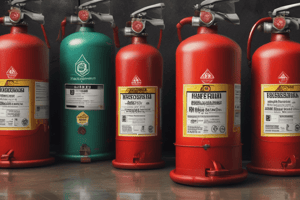Podcast
Questions and Answers
What does Class 1 refer to?
What does Class 1 refer to?
- Flammable solids
- Flammable liquids
- Gases
- Explosives (correct)
What does Class 2 refer to?
What does Class 2 refer to?
- Gases (correct)
- Explosives
- Flammable liquids
- Corrosives
What does Class 3 refer to?
What does Class 3 refer to?
- Miscellaneous
- Poison
- Flammable liquids (correct)
- Oxidizers and Organic Peroxides
What does Class 4 refer to?
What does Class 4 refer to?
What does Class 5 refer to?
What does Class 5 refer to?
What does Class 6 refer to?
What does Class 6 refer to?
What does Class 7 refer to?
What does Class 7 refer to?
What does Class 8 refer to?
What does Class 8 refer to?
What does Class 9 refer to?
What does Class 9 refer to?
What is the NFPA 473 standard for?
What is the NFPA 473 standard for?
What does the NFPA 704 standard provide?
What does the NFPA 704 standard provide?
What does OSHA PEL stand for?
What does OSHA PEL stand for?
What does NIOSH REL stand for?
What does NIOSH REL stand for?
What hazard does the red part of a placard indicate?
What hazard does the red part of a placard indicate?
What hazard does the yellow part of a placard indicate?
What hazard does the yellow part of a placard indicate?
What hazard does the white part of a placard indicate?
What hazard does the white part of a placard indicate?
What hazard does the blue part of a placard indicate?
What hazard does the blue part of a placard indicate?
Flashcards are hidden until you start studying
Study Notes
Hazardous Materials Classes
- Class 1: Explosives, highly reactive substances that can cause explosions under certain conditions.
- Class 2: Gases, which can be compressed or liquefied, posing risks such as flammability or toxicity.
- Class 3: Flammable liquids, substances that can ignite and sustain combustion.
- Class 4: Flammable solids, materials that can catch fire easily and burn rapidly.
- Class 5: Oxidizers and organic peroxides, substances that can contribute to combustion and amplify fire hazards.
- Class 6: Poison, materials that can cause harm through exposure or ingestion.
- Class 7: Radioactive materials, substances emitting ionizing radiation, posing health risks.
- Class 8: Corrosives, chemicals that can damage skin, eyes, or materials upon contact.
- Class 9: Miscellaneous materials, substances that do not fit into other hazardous classes.
NFPA Standards
- NFPA 473: Establishes competencies for EMS personnel responding to hazardous materials and WMD incidents.
- NFPA 1072: Defines qualifications for emergency response personnel in hazardous materials situations.
- NFPA 704: Provides a standardized system for identifying material hazards for emergency response.
- NFPA 472: Sets competence standards for responders to hazardous materials and WMD incidents.
Regulatory Framework
- CFR Title 29 1910.120: Outlines the hazmat awareness level requirements for workers.
- PEL: OSHA's permissible exposure limit that regulates maximum allowable exposure to chemicals.
- REL: NIOSH's recommended exposure limit, setting guidelines for safe levels of exposure.
Hazard Identification Placards
- Red part of placard: Indicates fire hazard associated with materials.
- Yellow part of placard: Represents instability, highlighting potential risks due to reactivity.
- White part of placard: Designates specific hazards that may be present.
- Blue part of placard: Reflects health hazards, warning about exposure risks.
Studying That Suits You
Use AI to generate personalized quizzes and flashcards to suit your learning preferences.




